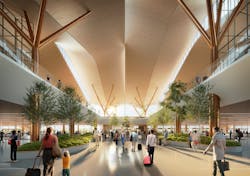Los Angeles International Airport (LAX) is improving the air quality inside its terminals to create a better overall experience for travelers.
Richard Yakel, air conditioning supervisor II for LAX, said the airport had numerous air quality complaints that usually stemmed around the smell of jet fumes in the terminals and the office areas.
“With the Bradley Terminal, the way the system was designed, it took in 100 percent outside air,” he said. “It really didn’t return much building air so most of the air being brought into the building was directly from the outdoors on the roof level, so when the winds would blow you’d get occasional jet fumes introduced to the terminal.”
While carbon filtration systems were effective, Yakel said not all the air handlers had them. LAX decided to add a bipolar ionization system to its air ducts to improve air quality within its terminals.
Steve Levine, president and CEO of AtmosAir Solutions, said LAX has challenges with air quality. Besides the general condition of the outdoor air and exhaust fumes, there’s a wastewater plant nearby.
“They really want the best in indoor air quality,” Levine said. “LA itself is in area where the air quality isn’t good. The outdoor air is bad to begin with and the indoor air is typically two to five times worse than outdoor air because indoor environments have carpet, machines and people and whatnot.”
Levine said typical air systems in airports have filters and other technologies addressing air quality on the return side. The bipolar ionization units LAX put in go on the supply side of the air.
“Really the two best words to describe our technology is creating this continuous disinfection as long as you have the air systems moving air and pushing air by delivering the ions to the space it’s creating this continuous disinfection that makes the air quality really fresh and healthy and that’s what they’re doing,” he said.
Pittsburgh International Airport (PIT) is connecting its landside and airside terminals as part of its terminal modernization program. Paul Hoback, chief development officer for the Allegheny County Airport Authority, said one aspect planners focused on involves nature, technology and community (NATECO).
Hoback said one of the most important drivers in an ASQ score is ambiance of the airport.
“We’re constantly looking at ways we can improve that,” he said. “This terminal modernization program is going to help us do that.”
Varughese Cherian, principal and east coast aviation leader for BuroHappold, is the project director for the PIT project. He said the overall project creates a great opportunity to address air quality inside the buildings.
“It’s a very old building and some of the filtration systems being used have been turned off over the years,” he said.
PIT’s air handling systems are nearly 30 years old, Hoback said, so the airport is upgrading them to make the best air quality possible. The new landside terminal will have all new equipment while airside terminal equipment will be upgraded to make improvements to the HVAC system.
Cherian said changing the ceiling in the terminal will also improve the interior ambiance. There are some areas where the duct work makes a lot of noise, which will be mitigated with new ceiling tiles while looking better than the existing material.
“From a passenger point of view, acoustics is probably one of the top three or four things we have to deal with,” Lyndon said. “The others being things like temperature, humidity and light. Acoustics are very noticeable.”
A Technological Solution
Heather Naida, vice president of connected technologies for Johnson Controls, said upgrading facilities technology needs to happen early on to discover what the pain points are for an airport. Once they understand the need and goals, they can determine the technology option to bring them the most value.
“It really starts with master planning,” Naida said. “If we’re in talking to customers early about what they’re trying to accomplish and how those outcomes will provide a better passenger experience, employee experience and overall airport experience, these integrations will come naturally during the construction process.”
Naida said airports can integrate information from audio visual displays into the HVAC system of an airport. This data allows facility managers to redirect the energy sources to other areas of the terminal when one area is less busy.
“It saves money, it reduces maintenance and physical security requirements because we know that aspect of the terminal is not being used,” Naida said. “This is something through very simple integration that pretty much all of our airport customers use, but at the same time, there’s a lot of airports that don’t do this integration.”
Karl Lyndon global aviation leader for BuroHappold and project partner for PIT, said they’ve measured carbon dioxide levels inside the existing terminal to find a balance between energy efficiency and passenger comfort.
Cherian said Pittsburgh’s location by mountainous areas means high winds and cold temperatures meant designers wanted to have an optimal indoor air quality for travelers.
“We looked at the weather-related data in that area and tried to introduce more comfort conditions,” he said.
When AtmosAir showed its technology to LAX and they experienced what it would do for odors and VOCs, Levine said leaders recommended they install this in the different air conditioning systems in the different terminals.
“When I first saw it in use was at a wastewater treatment plant and you can imagine the orders inside one of those,” Yakel said. “It was really doing a good job of removing odor so I was pretty impressed right then and there.”
Levine said the units were first added to the Tom Bradley Terminal, then Terminal 7, Terminal 5, Terminal 3 and most recently the new Midfield Terminal. The plan is to continue putting the technology in different terminals they’re renovating.
“You go into a normal building, for example, and they’d take ion readings and they were pretty low,” Levine said. “By adding our systems in, they raise those ion levels and those ions attack the contaminants in the space and they pull out of the air things like particles, spores they break down different VOCs and odors and they attack the different bacteria viruses and germs.”
New systems have the bipolar ionization systems installed before being placed inside a terminal. Levine said existing ducts were retrofitted at LAX to install the tubes into the system.
One tube can address about 2,000 CFM of air. Each AtmosAir unit handles about 15,000 CFM, so each unit has about eight tubes.
More than 2,000 tubes have been installed at LAX so far, which would require an annual changeout.
“We have retrofitted almost all of our air handlers to the two-year tube now so it saves us labor costs because instead of doing it every year, we can do it every two years,” Yakel said.
LAX recently installed an air monitoring sensor system, which feeds into the building maintenance system and allows staff to continuously monitor the air quality in the terminal. Additional ions can be put through the vents during peak hours to address air quality issues and adjusted down for non-peak hours when there is less traffic inside the terminal.
Yakel said LAX is using the monitoring systems in one building and is the air in the building.
“From what we’ve seen, it’s definitely providing some good feedback,” he said.
Better air quality provides a better traveler experience inside the terminal, which Levine said will make them more apt to pick utilize the airport over other choices and help staff.
“An employee has to come to work every day and if they’re breathing in bad air, absenteeism could become an issue, retention of employees become an issue and productivity of employees become an issue,” Levine said. “If you can create a better air quality, not only is it good for the people that go through the airport, but also for the employees as well.”
A Window for Success
Alan Howell, senior airport architect, airport development department for the Metropolitan Airports Commission, said Minneapolis St. Paul International Airport (MSP) has addressed air quality and passenger comfort through a wholistic approach to sustainability.
This also includes the installation of electrochromic glass to address heat and brightness issues inside the terminal.
“In the departures area in concert with the solera glass, is really a chance for us to provide a passenger comfort so you’re not standing in direct sunlight,” he said. “There’s also an operational need both for the ticketing agents and TSA operations to reduce glare as well as heat buildup.”
MSP installed Sage Glass, which uses sensors to set the coloration of the glass based on brightness outside the terminal. The solera glass refracts the light throughout the space.
“We get some real good compositional elements from an aesthetic standpoint,” Howell said. “We also get the energy savings, we get the customer comfort and we get the operational safety and security based on TSA needing to be able to do their job really well.”
Howell said TSA asked MAC in 2007 to install big red curtains in front of the terminal to make it dark inside. Ticketing agents were also complaining about the amount of light reflecting off the floor after the surfaces were cleaned.
“It’s not so much that it was warming the space as it was uncomfortable for people,” Howell said. “If you were standing in line waiting for TSA and it was as bad day, standing in that space before the work happened was more uncomfortable than it should be.”
The first electrochromic glass was installed at MSP in 2015. More have been installed each year across the terminal since, with plans to continue through 2023. Each installation takes about nine months Howell said, given the changes the airport is making to the overall structure.
Howell said staff did sunlight simulations to determine how much natural light would penetrate the terminal at different times of the year. They want more light getting in during the winter months to naturally heat the space, while balancing operational concerns.
“We know with our new mechanical system that we’ve installed as part of this project in the north and south headhouses that indeed we’re saving dollars with regard to energy because of the glass and cutting down the radiation coming through,” Howell said. “Also, we have much more efficient mechanicals than we had six months to two years ago.”
Howell said airport leaders looking at this technology should not only visit airports with electrochromic glass, but other buildings in their region with the system.
“If you were in Atlanta, there are quite a few buildings that have electrochromic glass,” he said. “It’s a different heating and cooling environment than in Minneapolis/St. Paul, but it’s going to give you an idea of how it’s going to perform elsewhere.”
Physical Changes for Success
PIT used to be an airside satellite building, so it was surrounded by aircraft on all sides, so there was no good places to bring air into the terminal.
“That’s changing now,” Lyndon said. “Becoming a single route terminal with a landside component, we take ventilation air where we can from the landside to avoid the kerosene exhaust.”
PIT generated feedback from travelers via ASQ surveys and sending its marketing and communications team to community events to find areas that airport can improve its overall terminal experience. They even held a holiday open house in December to get feedback from the community.
Hoback said the new terminal will also bring landscaping inside the facility to improve the ambiance and air quality.
“The great thing about bringing plants into a building is from a passenger experience point of view, people know that plants are typically doing the right thing for them,” Lyndon said. “They’re a visible conditioners. They remove CO2, the also remove dusty and help with acoustic absorption.”
Large glass windows will bring a connection to the outdoors.
“One of the things we’re doing is creating outdoor space on the airside of the terminal,” Hoback said. “Once you’re through security, you’re going to be able to go outdoors.”
Lyndon said other airports across the world are adding outdoor space to terminals because passengers are generally stuck inside for hours.
“From a passenger comfort level, that’s suboptimal,” he said. “Places like Singapore and Pittsburgh are now introducing outdoor spaces so you know when you go into the airport environment you still have the opportunity to go outside if it’s a nice day.”







